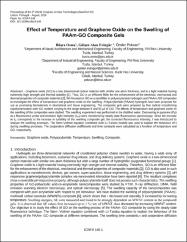Effect of temperature and graphene oxide on the swelling of PAAm-GO composite gels
Abstract
Graphene oxide (GO) is a two dimensional carbon material with similar one-atom thickness, and is a light material having extremely high strength and thermal stability [1]. Thus, GO is an efficient filler for the enhancement of the electrical, mechanical and thermal properties of composite materials [2]. We focused on GO as a nanofiller in polyacrylamide hydrogels and PAAm-GO composites to investigate the effect of temperature and graphene oxide on the swelling. Polyacrylamide (PAAm) hydrogels have been proposed for use as promising biomaterials in biomedical and tissue engineering. The composite gels were prepared by free radical crosslinking copolymerization with GO content varying in the range between 8 and 50 ?l of GO. The effects of temperature and graphene oxide on the swelling of the composites were studied. The swelling experiment was performed in the distilled water. Decreasing in pyranine (Py) as a fluorescence probe and emission light intensity (Iem) were monitored by steady state fluorescence spectroscopy. Since the increase in Isc corresponds to the increase in turbidity of the swelling composite gel, the corrected fluorescence intensity, I was introduced to analyze the swelling processes. The Stern-Volmer equation combined with Li-Tanaka models was used to explain the behaviour of I during swelling processes. The cooperative diffusion coefficients and time constants were calculated as a function of temperature and GO, respectively. © 2019 Avestia Publishing.

















